Telangana SCERT 6th Class Social Study Material Telangana 17th Lesson Religion and Society in Early Times Textbook Questions and Answers.
TS 6th Class Social 17th Lesson Questions and Answers -Religion and Society in Early Times
(Improve Your Learning)
Question 1.
List some Religious practices of the people of the following. (Conceptual understanding)
Answer:
| Hunter-gatherers society | Present-day society |
| 1) Painting and dance were important parts of the religious practices of the hunter-gatherers. | 1) The society is under the sway of scientific temper. |
| 2) Forests and wild animals were sacred and had to be worshipped. | 2) Science is considered more logical and rational than religion. |
| 3) Animals should not be killed except the web of superstitions and rituals. | 3) The poor, ignorant, and illiterate are in need. |
| 4) Many early hunters buried the dead along with some objects. | 4) Some people are attempting to spread the scientific message of Vedanta all over. |
Question 2.
Write about the common characteristics/ tenets of Buddhism and Jainism. (Conceptual understanding)
Answer:
The common characteristics/tenets of Buddhism and Jainism
1) Both religions have faith in penance and meditation.
2) Both preached Ahimsa’ or Non – Violence.
3) Both taught us to live austere life,
4) The books on Buddhism and Jainism and religious preachings were in Prakrit the language of the ordinary people.
Discuss and Write
Question 3.
How do you think we can express our thanks to nature? (Appreciation and Sensitivity)
Answer:
The people in our society are nature lovers. Our country is an agricultural country. The people believed that trees and animals like snakes were sacred and had to be worshipped. From the past, our society started worshipping the nature in man’s ways – some people offer flowers, some offer milk and fruits, some perform yagnas, and some chant holy hymns. We can express our thanks to trees by not killing or cutting them. We have to plant more trees. Trees help to control the air pollution. We can express thanks to snakes by not killing them and by not removing ant hills which are their houses.
Question 4.
We sometimes see people causing suffering to, and terrorising animals. What do you think about this? Do we have the right to cause pain to any living being? (Appreciation and Sensitivity)
Answer:
We see people .. causing suffering lo,. and terrorising, animal by hitting with stones. like humans, animals are also living beings. They have life. They also feel We ought to show mercy towards dumb creatures. We have no right to cause pain to any living being. Live and let live.
![]()
Question 5.
Why did people worship dead ancestors and kept boulders on the buried sites? (Conceptual understanding)
Answer:
The stone boulders known as Megaliths are big stones, People believed that if they worship the dead ancestors. the’ bless them. The people believed that the souls of dead ancestors took rest in the buried sites. They kept boulders believing the souls of ancestors not to leave the buried sites. As an indication and mark that there are dead ancestors beneath the burial sites, the used to keep boulders.
Question 6.
Identify the megalith areas in the map of India and colour those areas. (Mapping skills)
Answer:

Question 7.
Write about the different religious customs that are practised in your area. (Reflection on contemporary issues and Questioning)
Answer:
India is known for its diversity of religions. castes and races. In my area, though majority Population consists of Hindus, Muslims and Christians also occupy minor shaw.
Hindus:
1. Hindus worship several gods based on their beliefs and oiler prayers to idols present in temple.
2. Priests chant mantras from vedas and takes care ail temple relate activities. People worship god through bhajans, keertans, etc, and also offers flowers, fruits, milk, coconut, etc.
3. The practice of circumambulation (ఞహాోగ్పీస్ధిఊ) )around temple is generally observed in Hindus.
4. The other practices like offering haarati,having religious colours ![]() etc., on fore head etc.. are also observed.
etc., on fore head etc.. are also observed.
5. The other important practice, animal sacrifices are most common related to female godesses like Durga. Mahankali, Poleramn’ia, Ganganamnia etc.,
Muslims:
1. Muslims do not believe in idol worship and oiler their prayers to Allah in chanting holy lines from Koran
2. Women should cover her body with black colour attire called “Burqa” and head covered with viel.
Christians:
1. Christians worship Jesus Christ in form of idol or cross symbol
2. Gcneratlv prayers are offered in form of songs and messages from ffiLie.
Question 8.
Read the para under the title ‘What is it that will never perish?’ from textbook page 150 and comment on it. (Reading this text (given), understanding and interpretation)
What is it that will never perish?
In those days, many people went to live in these forests in ashrams. In these ashrams. they meditated and pondered over several questions. They also had discussions with wople who came to visit them and shared their teachings with others. People who lived in ashrams like this were called Rishis and Munis (sages). Several kings too were in the forefront of this kind of thinking. Tise views of these rishis and kings can be read in tests called the Upanishads. Yagnavalkya and Uddalaka Aruni were famed rishis of those times.
The rishis were in search of something which would neither die nor be afflicted by sorrow. They called this indestructible being the Amia or Brahrnan, They believed that by understanding the atma or Brahmian. They could be attained. In order to Know the atma. one had to perform penance or tapasya.
Answer:
1. The above-mentioned paragraph discusses the way’ of life in ashrams in olden days.
2. Ashrams are the place of living in forests where people used to meditate and get answers to various unknown questions in tapasya.
3. Rishis and munis preach. the followers about different aspects of life.
4. They were in search of in destructible being called Almas or Brahman which can be attained by performing tapasya
![]()
(Project Work)
Question 1.
Draw pictures nf different modes of worship and prepare a small booklet on it for your library. (Information Skills)
Answer:
There are many religions in the world. Every religion has its own mode of worship. The ultimate goal of all religions is love toward others. All the religions believed that God is one,
a) Hinduism:

b) Islam:
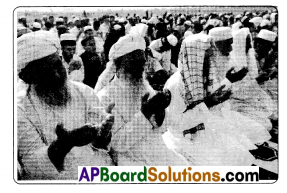
c) Christianity:
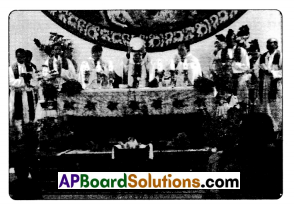
d) Sikhism:
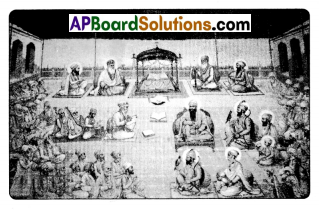
Some more pictures to be collected by students.
Question 2.
Visit different places of worship in your area. Interact with the Head priest/ Religious head with the following questionnaire and note down his? her views and prepare a report.
a) Why do people come to holy places?
Answer:
People come to the worshipping centres to otter prayers to the God.
b) How do the people conduct worship there?
Answer:
People worship gods and addresses in and was. Some people offer flowers to sacred idols. Some perform vagnas and some chant holy hymns silently,
c) What are your views on Moksha/Salvation?
Answer:
All the religions preach that there are so many ways to reach god. Through devotion to god alone, salvation can be attained by man.
d) Do you think this kind of worship is Indispensable? essential for the mankind?
Answer:
Worshipping gives peace of mind. It develops love towards fellow beings.
Intext Questions
Question given in Box P. No. 143
Question 1.
What do you think hunter-gatherers would pray for? Who do you think would they pray to?
Answer:
Hunter-gatherers believed that the forests and wild animals were sacred and had to be worshipped. They worshipped many animals too by drawing their pictures on caves.
Question given in Bo P. No. 144
Question 2.
What kind of change do you think would have come about in the religion of the early farmers and herders?
Answer:
Early farmers worshipped Mother Goddesses or Mother Earth. may believed that the crops and cattle would prosper with her blessings. Mother Goddesses were worshipped in the form of small images. The early animal herders worshipped god by burning sea sonal bonfire rituals.
![]()
Question given in Box P. No. 146
Question 3.
Look at the picture given below carefully and describe it. Does it resemble any God you know?
Answer:
This picture may he a God similar to Shiva worshipped in later times in various parts of India. They worshipped the idol of Pasupathi.
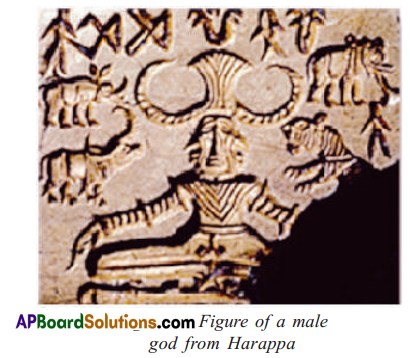
Questions given in Box P. No. 147
Prayer to Indra
Indra, Please come and accept our offerings. Just as the hunter moves in search of prey, we too axe going to war in search of wealth. Indra, please help us to win the war. O Indra, give us limitless wealth, fulfil our wishes by granting us hundreds of cows.
Vishvamltra and the Rivers:
Vishvamltra : 0 rivers, come down from the mountains like two swift horses, like two
shining cows that lick their calves. You move like chariots to the sea, through the power of Indra. You are full of water and wish to unite with one another.
The rivers: We, who are full of water, move along the path the gods have made for us.
Once we start flowing, we cannot be stopped. Why do you pray to us. o sage?
Vishvamitra :0 sisters, please listen to me, the singer who has come from a distance with his chariots and carts, Let your waters not rise above our axles, so that we can cross safely.
The rivers: We will listen lo your prayers to that you can cross safely.
Question 4.
Who are the two hymns addressed to?
Answer:
The first hymn was addressed to Lord Indra.
The second hymn was addressed to the rivers.
Question 5.
What do you think are the Rishii offering to the Gods?
Answer:
The rishis are offering sacrifices to the gods for salvation.
Question 6.
What are they praying for?
Answer:
They are praying for cattle, for horses, and society.
Question 7.
Do you think these people would be hunter gathers or cattle herders or people living In villages and cities?
Answer:
I think they are cattle herders, lived in India between Hindukush Mountains and the Yamuna River.
Question given in Box P. No. 149
Question 8.
Does your family worship or show reverence to the ancestors ? Find out which of your
ancestors are worshipped – both male and female. Share it in your class.
Answer:
In our society, people considered it important to worship the ancestors – both male and female by offering prayers. We worship our ancestors by offering pangal and new clothes on the occasion of Pongal festival.
Questions given In Box P. No. 150
Question 9.
What do you think that happens to us after death? Discuss in the class?
Answer:
Rationalists say that there Is nothing after death. Nobody knows what happens after death. Different religions comment differently. They are religious beliefs that have no physical proof.
![]()
Questions given In Box P. No. 151
Question 10.
Relate what you have heard about Alma and Tapasya.
Answer:
An indestructible being is called Atma or Brahman. By understanding the Alma or Brahman, immortality could be attained. In order to know the alma, one had to perform penance or Tapasya. Vardhaman Mahavira and Gowihama Buddha got enlightenment by hard penance.
Questions given in Box P. No. 152
Question 11.
What is the question to which Nachiketa was seeking an answer?
Answer:
Nachiketa was seeking an answer to the question. ‘What happens after death’?
Question 12.
What were the rishis seeking?
Answer:
The rishis were in search of something which would neither die nor be afflicted by sorrow. They called this indestructible being the Atma or Brahman.
Question 13.
Why did Mahavira say that we must not give pain to any living beings?
Answer:
Mahavira taught the people that when we inflict sorrow on other living beings, we add to our load of sins. Therefore, as far as possible we should avoid hurting any living being. We should show mercy towards small living beings.
Question 14.
What did Buddha suggest as a way of getting rid of misery?
Answer:
According to Gautama Buddha, sorrow is caused by excessive craving and desire. We can attain freedom from sorrow if we control our desires. In order to gain control over our desires, we need to live a balanced and controlled life and should not cause pain to any living being.
Question 15.
You too must have seen many sadhus who wander from place to place. What do sadhus do and what do they preach?
Answer:
Many sadhus wander from place to place. They did not live permanently in any one place. They preach us about truth. may are the truth seekers.
Fill in the blanks: Page No. 152
1. …………………. (a) lived in ashrams whereas………………….. (b) wandered from place to place.
Answer:
a) Rishis, b) Munis
2. The views of rishis like Yagnavalkya are recorded in the ……………………. .
Answer:
Upanishads
3. The religion spread by Mahavira is known as ……………….. .
Answer:
Jainism
4. The religion spread by Buddha is known as ………………… .
Answer:
Buddhism
(Additional Questions)
Question 1.
Read the information carefully and answer the questions.
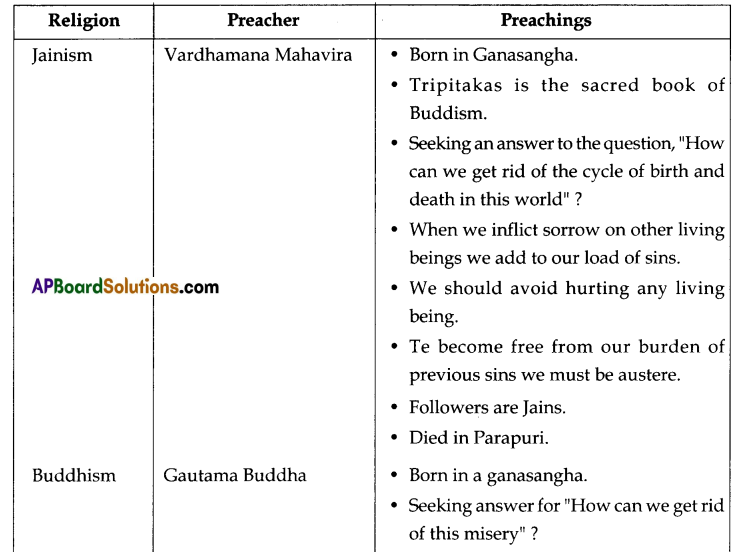

Answer the following questions:
1. Who was the founder of Jalnism?
Answer:
Vardhamana Mahavira was the founder of Jainfsm.
2. What was the question which Gautama Buddha was thinking about?
Answer:
Gautama Buddha was thinking about answer for the question. How can we get rid of this misery?
3. To become free from our burden, What should we do?
Answer:
It is the picture of masked dancer. He had his head dressed, decorated arms and hand. The picture belongs to hunter-gatherers.
3. To become free from our burden, What should we do?
Answer:
To become free from our burden of previous sins, we must be austere.
4. Write some similarities in both religions Jainism and Buddhism.
Answer:
- Vardhamana Mahavira and Gautama Buddha both became Parivrajakas.
- Both searched to know the answer for their questiom.
- Both of them preached non-violence.
5. who are Jams? Who are Buddhists?
Answer:
The followers of Mahavira are Jams.
The followers of Buddha are Buddhists.
Question 2.
On a map locate the settlements of Vedic people in given India map.
Answer:
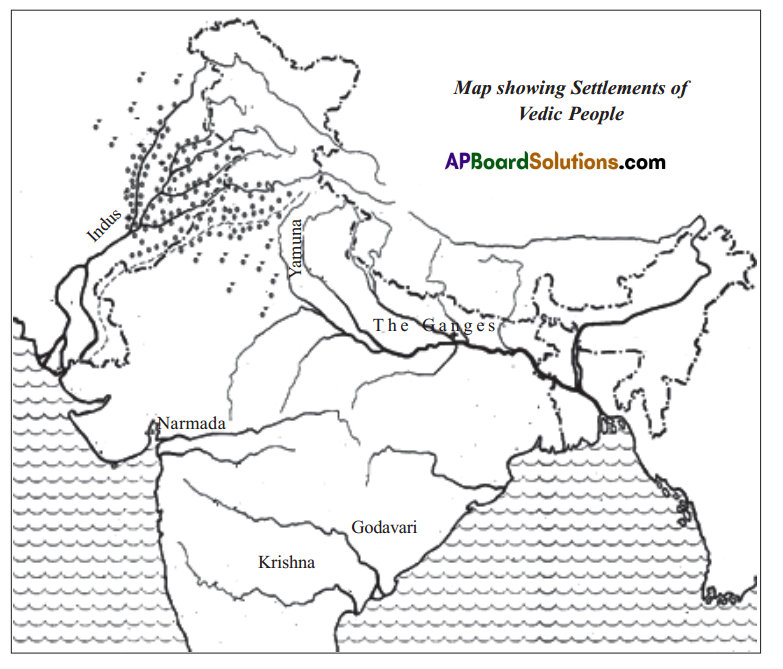
Question 3.
Write about the below pictures?
a.

Answer:
It is the picture of masked dancer. He had his head dressed, decorated arms and hand. The picture belongs to hunter-gatherers.
b. The picture shows the baked clay figure of Mother Goddess of 5000 years old belonged to hunter-gatherers. They probably believed that the crops and cattle would prosper with her blessings.
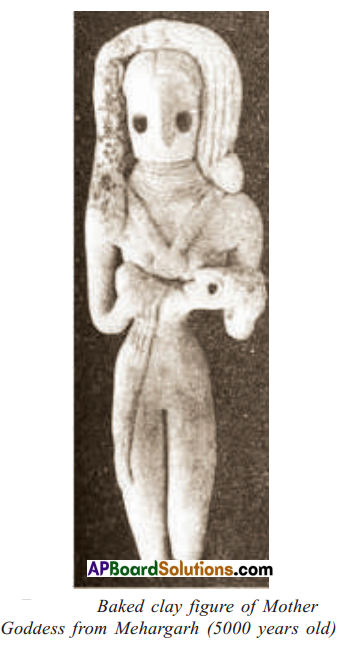
c.
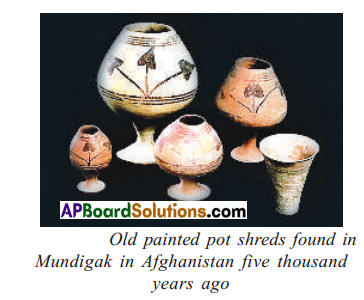
The above picture is the old painted pot Shreds that belong to 5000 years ago. potshreds from very ancient times have pictures of peepal leaves painted on them indicating the people had great regard for these trees.
d. This picture is Mother Goddess that belonged to Harappan culture which flourished 4t00 years ago. The Harappan people wor shipped Mother Goddess (Amma Talli)
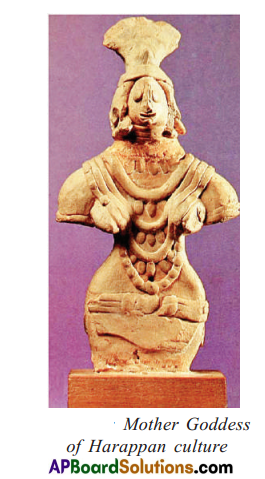
Two marks Questions
Question 1.
Whom did the Hunter-gatherers worship?
Answer:
Hunter-gatherers worshipped forests and wild animals.
Question 2.
Whom did the Chernhus worship?
Answer:
They worshipped Goddess called Ganagamma and also worshipped Mallyya of Srisailam.
![]()
Question 3.
Whom did the early farmers worship?
Answer:
The early farmers worshipped MotherGoddesses or mother earth.
Question 4.
What is the other name for Indus valley civilization?
Answer:
Harappa civilization.
Question 5.
Whom did the people of Indus worship?
Answer:
Indus people worshipped Siva in the form of Pasupathi and they also worshipped’ “Mother Goddess”.
Question 6.
Write the names of two rushies.
Answer:
Yagnavalkya and Uddalalca Aruni.
Question 7.
What is indestructible?
Answer:
Atma or Brahman is indestructible.
Question 8.
How can we know Alma?
Answer:
In order to know Atma, one had to perform hard penance or tapasya.
Question 9.
Who were Parivrajakas?
Answer:
The truth seekers who wandered from place to place were Panvraiakas.
(Objective Type Questions)
Question 1.
Masked dance was practiced by ( )
A) Rishis
B) Kings
C) Hunter-gatherers
D) Sadhus
Answer:
D) Sadhus
Question 2.
The book that describes the religious practices of hunter-gatherers living near Sri Kalahasthi. ( )
A) Sthala Puranam
B) Periya Puranam
C) The Vedas
D) Upanishads
Answer:
B) Periya Puranam
Question 3.
The shepherd group in Maharashtra ( )
A) Colla
B) Yadava
C) Kuruma
D) Dhangar
Answer:
D) Dhangar
Question 4.
Pot shreds from very ancient times have pictures of the …….. leaves painted on them. ( )
A) Peepal
B) Mango
C) Banyan
D) Tulasi
Answer:
D) Tulasi
![]()
Question 5.
The Vedas were composed by …………………. .
A) Shepherds
B) Rishis
C) Kings
D) Hunters
Answer:
B) Rishis
Question 6.
A plant from which a special drink was prepared. ………………. . ( )
A) Peepal
B) Neem
C) Mango
D) Soma and Sura
Answer:
D) Soma and Sura
Question 7.
The views of the rishis and kings can be read in texts called
A) Vedas
B) Upanishads
C) Puranas
D) Pitikas
Answer:
B) Upanishads
Question 8.
Gautama Buddha became a ………………. .( )
A) Bhikshu
B) Panvrajaka
C) Hunter
D) King
Answer:
D) King
Question 9.
The teachings of Buddha came to be known as ( )
A) Hinduism
B) Jainïsm
C)Sikhism
D) Buddhism
Answer:
D) Buddhism
Question 10.
The followers of Vardhamana Mahavira are ………………….. . ( )
A) Jains
B) Muslims
C) Sikhs
D) Buddhists
Answer:
A) Jains